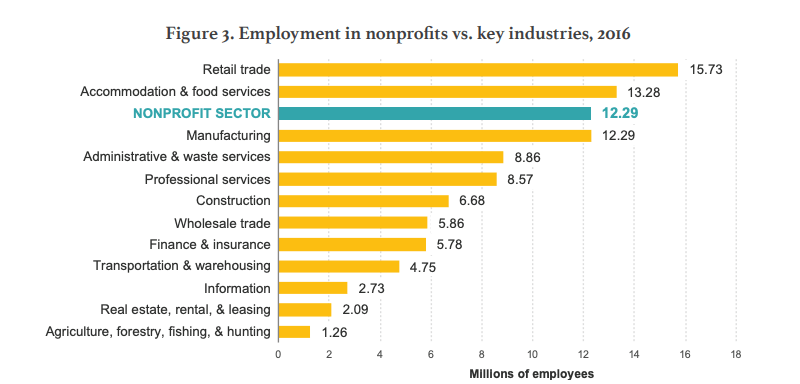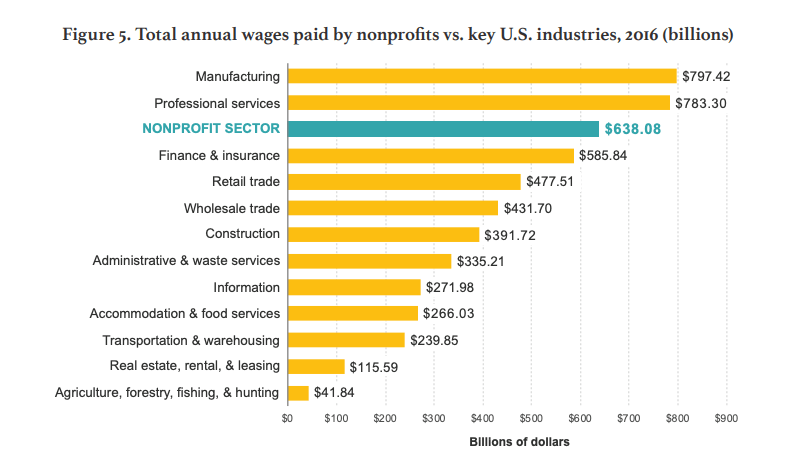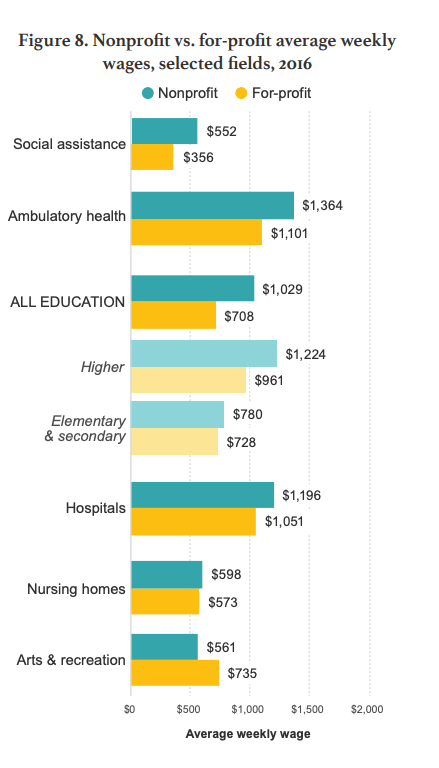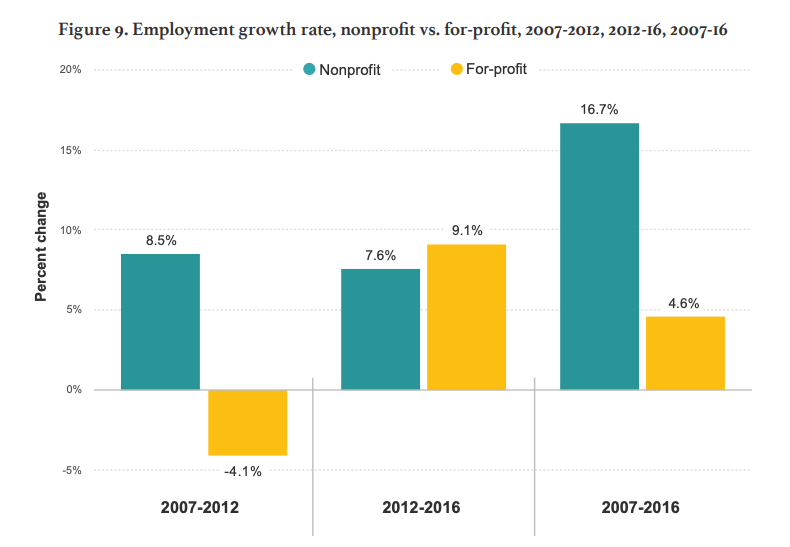What the Growth in the Nonprofit Sector Means for You

Good news, folks—the nonprofit sector is looking more lively, vital and resilient than ever.
Results from the Johns Hopkins Center for Civil Society’s 2019 Nonprofit Employment Report show that the nonprofit sector is not only one of the largest employment forces in the nation, but also a significant contributor to employment growth, even in recessionary periods. Here’s what these positive conclusions mean for you and your organization.
Note: This study used statistics from 2007 to 2016 to show the sector’s performance during and immediately after the recession, and also because this was the most recent year that data was available. As you read, keep in mind that some data may have changed, and continue to do research as new studies are released!
Size
Let’s first look at the sheer mass of the sector. When treated as a single “industry,” nonprofits are the third largest workforce in America, behind retail and food services, employing 12.3 million people in 2016. There are twice as many nonprofit workers than there are in each of the nation’s transportation, trade, finance and insurance industries, and they account for 10.2 percent of the country’s workforce.

Additionally, the nonprofit sector is the third largest generator of payroll income in the country, behind only manufacturing and professional services. The sector paid its employees over $638 billion in total wages in 2016, which is over 30 percent more than the retail industry (the largest employer, mind you), 60 percent more than the construction industry and over 14 times more than the agriculture industry.
What does this mean for you?
Whether you view the glass half empty or half full is up to you—a large sector means more competition, but it also means more opportunities. Find your niche within the sea of over 1.5 million nonprofits in the country, and be comforted by the fact that the sector is thriving as a whole.
Pay
Nonprofits get a bad rap for offering lower salaries than for-profits, but the data in this study proves otherwise. at least regarding organizations that operate in the same field. In all but three categories, nonprofits paid higher weekly wages than their for-profit counterparts. For example, nonprofits in the social assistance category paid 55 percent more, nonprofit educational institutions paid 45 percent more and nonprofit healthcare organizations paid 24 percent more.

What does this mean for you?
If any of your employees or peers have considered switching to the for-profit side for monetary reasons, they may want to reconsider. Unless you’re in arts and recreation, the nonprofit sector will treat you just as well, if not better, than for-profit companies doing the same work. Use this as encouragement for your employees—and yourself—to help your team stick around and combat the sector’s high turnover rates.

Resiliency
From 2007 to 2016, the nonprofit sector increased its workforce by 16.7 percent, while for-profits only saw a 4.6 percent total increase. What’s especially impressive is that during the notorious 2007-2008 financial crisis, the sector actually grew while the corporate world saw an employment loss of 4.1 percent, which translates to more than 4 million people without jobs.
The study attributed the nonprofit world’s success in the midst of an economic storm to America’s overall shift toward a service economy, demographic trends (for example, more females in the workforce), the expansion of government funding and “the counter-cyclical nature of many of the government safety net programs, which causes funding to expand when recessionary pressures disrupt normal sources of revenue.”
While the for-profit world recovered from the recession, the nonprofit sector still saw 4 times its growth over the 9-year period of the study.
What does this mean for you?
Despite the 2007 recession, the tax cuts of December 2017 and many other economic ups and downs, the nonprofit sector has remained strong. People need nonprofits regardless of the condition the country is in—and possibly even more so when conditions are bad.
If your organization is in a stable place, use this to gain your community’s trust. Let supporters know that you’re not only a solid long-term investment choice, but also a reliable resource for people to turn to when things go wrong.

If you survived having all these facts and figures thrown at you, congratulations. As overwhelming as statistics may be, it’s important to have a solid understanding of the nonprofit workforce if you’re one of its employees. Data like this can provide crucial insight and, in this case, a positive projection of what’s to come.
The post What the Growth in the Nonprofit Sector Means for You appeared first on Nonprofit Hub.









Leave a Reply